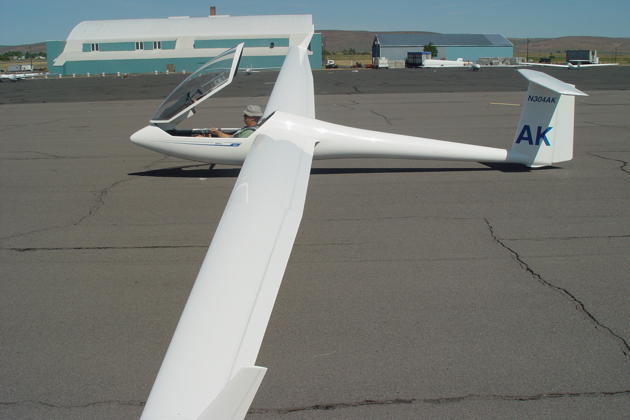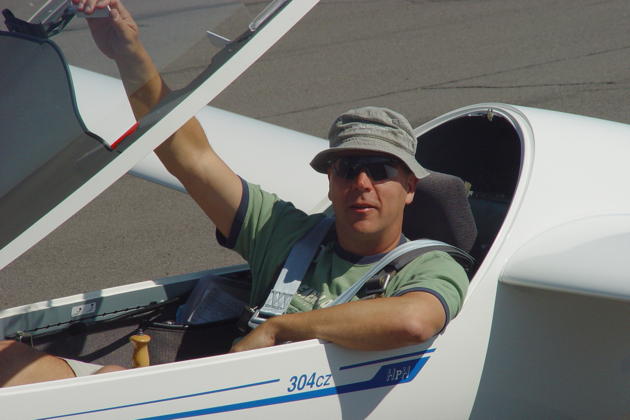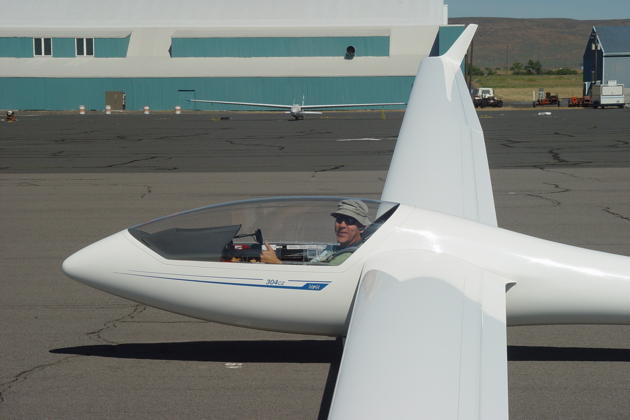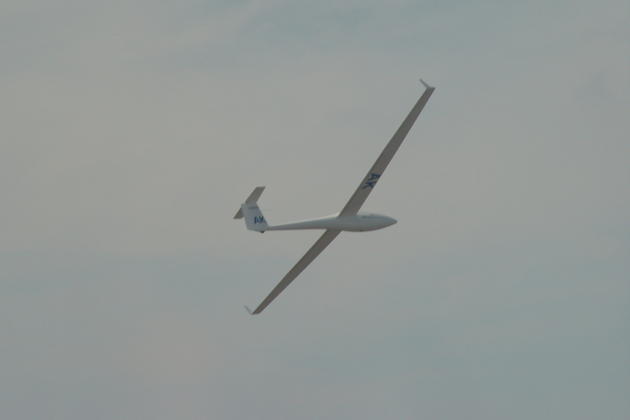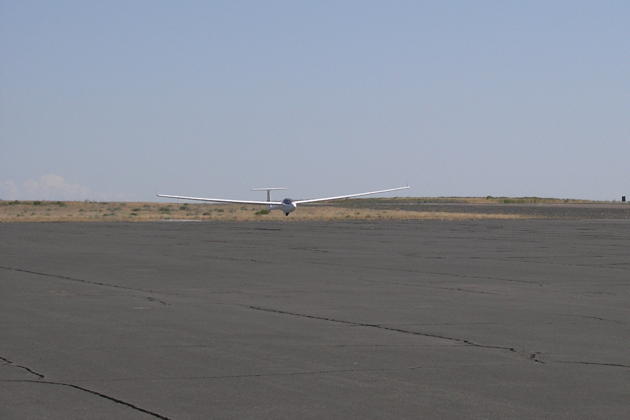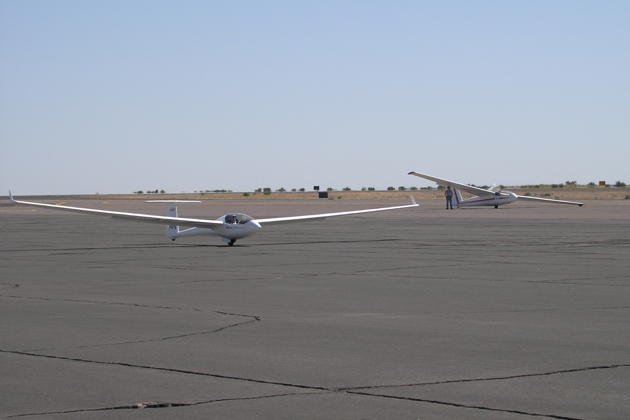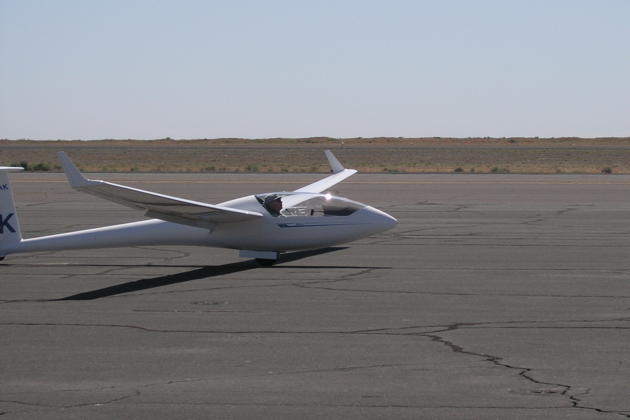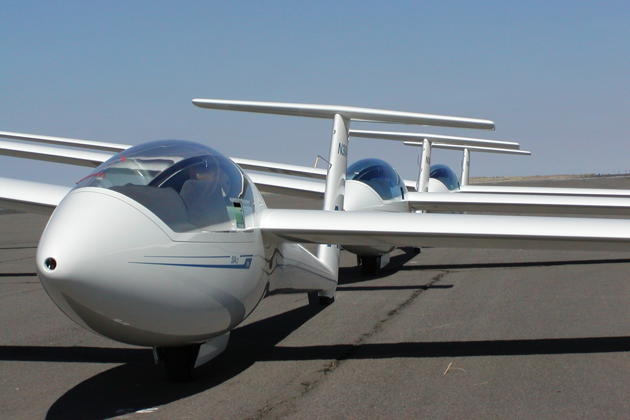FlightLog Archive
∟Aircraft Flown
Soaring in the HpH 304 CZ - May 2006
A few years ago, I had the pleasure of preparing Alan Kirlin for his first flight in his brand new HpH 304 CZ 15-meter sailplane. After Alan’s successful first flights, he offered me the opportunity to fly his beautiful ship whenever we were both in Ephrata. After a few missed opportunities due to weather and schedules, I was finally able to coordinate a chance to fly the 304 CZ.
The 304 CZ is a modernized version of the 1980s German Glasflügel 304 sailplane. In the late 1990s, the HpH company in the Czech Republic acquired the tooling and manufacturing rights for the 304 model sailplane, and resumed its series production as the 304 CZ. The new HpH-produced model has been modified by adding winglets to the basic 15 meter configuration and providing optional tips, extending the span to 17.4 meters.
I studied the 304 CZ manual, and discussed its flying characteristics with Alan and other 304 CZ owners, such as Pierre Parent and Linda Chism. A few minor differences that I should look for were: a parallelogram stick, very effective spoilers, and a heel brake system. Other than that, the 304 CZ was described as a joy to fly, with good performance.
After a thorough cockpit check and an instructor sign off, Alan and I pushed the 304 CZ to the line at Ephrata. I planned on two flights, one in the 15 meter configuration, and the second with the 17.4 meter tips. After strapping in, I noticed that the seat pan is very deep, and was surprisingly comfortable and gave good support to my thighs, probably reducing fatigue on long flights. I got a feel for the flap handle, which can be set in any of six positions, two of which are positive (down) for thermaling and two are negative (up) for higher speeds, plus neutral and landing settings. Typically on take-off and tow the flaps were set in the +1 position, which provided decent aileron control early in the takeoff roll. In crosswind conditions, the flight manual mentioned a negative flap option early in the takeoff roll, which wasn’t needed today.
I was looking forward to flying with the traditional Glasflügel parallelogram type stick, which I found was very light and comfortable right on takeoff, with no tendency to PIO. The stick-mounted spring trim system is actuated by pressing on a button located near the base of the handgrip, and was easy to use, and effective throughout the practical speed range. It also could be set by moving a small knob mounted on a semi-circular wheel on the parallelogram control column just ahead of the pilot's fingers.
On tow, the 304 was a joy to control. I brought up the landing gear halfway through the tow, which was easily accomplished with one hand. Although it was early in the day, some signs of beginning lift were felt on tow. Once off tow, I was able to jump into a few small thermals to get a feel for the 304 CZ’s good handling qualities. Coordination was fairly easy, but I did find myself adding a bit too much rudder initially in thermaling turns. In addition to the expected yawstring indication, the airspeed indicator definitely demonstrated signs of yaw sensitivity. As the airspeed indicator quickly zoomed down toward zero, it acted as another good yaw attention-getter. Once I got a feel for the control forces, I found the 304 CZ easy to thermal at comfortably slow airspeeds in the low 40s. The sailplane climbs well in thermals when using its +1 thermaling flap setting, and I also tried the +2 flap setting for thermaling more tightly, and that also worked well. I tried a few stalls, which were very gentle, and easily recoverable with reduced back pressure, with little tendency to drop a wing.
After working some small bits of lift for about 30 minutes, I tried a practice approach at altitude to get a feel for the flaps and dive brakes. Initial movement of the dive brake lever brings out brakes only, then as the lever is moved further back, the dive brakes are actually a combination of flap and trailing edge spoiler, creating a very powerful system with almost no trim change throughout its range. The braking effect makes it necessary to pitch the nose well down to maintain a constant approach speed, but steep, relatively slow approaches and short landings can be easily achieved. I kept my altitude somewhat high on my base-to-final turn, and then was impressed with the 'get down now' capability afforded by the full dive brakes. I eased back on the spoilers approaching the flare, and was rewarded with a very smooth touchdown (beginner’s luck)!
As I mentioned earlier, your heels actuate the wheel brake. You simply push both heels forward together, which moves the entire rudder pedal assembly forward and actuates the wheel brake. During the rollout, I moved the flaps to the -2 position, and had full aileron authority almost until I stopped, with wings level. Wonderful sailplane!
I was now ready for some real soaring, so Alan and I quickly changed the tips into the 17.4-meter configuration. After another smooth launch and tow, I had a great 3+ hour flight, getting a good feel not only for thermaling, but also trying out the cruise capability afforded by the longer wings and the negative flap settings.
About halfway through the second flight, I was cruising inter-thermal at about 5000’, and I was admiring the great visibility. Alan’s 304 CZ canopy is immaculate, and I was also testing out a brand new pair of Oakley sunglasses. I definitely felt like I could see forever, and did notice some large specks in the distance to the west. Growing larger, I noticed these specks were three C-17s, en route from McChord AFB, and transiting near our airspace while letting down for approaches at nearby Moses Lake. While they were at my altitude, their heading took them well clear, but I did call out their position for other Ephrata sailplane traffic. About that time the three-ship turned, and were now pointing DIRECTLY at me. I put them on my nose to judge relative motion, and the center C-17 was directly nose on, with zero relative motion, now co-altitude about two miles ahead of me. Although he couldn’t beat me for nose position, he definitely had me beat for gross weight, so I rolled up to give him a wing flash, and headed 45 degrees to the right. Once I saw that we would miss each other, I rolled back to keep all three C-17s in sight, passing about 1500’ 180 degrees out from the nearest C-17. I quickly pulled to rollout at the nearest C-17’s six o’clock, for a quick 'fade away' simulated AIM-9 shot. I doubt if they ever saw me, but I again said thanks for clear canopies and great vis! The landing with the 17.4 meter tips was again no problem, although I did have to dodge the rotor wash from a helicopter that flew diagonally across the Ephrata glider landing area about 45 seconds before I touched down.
In summary, the overall feel in the 304 CZ is of a pleasant high performance sailplane that is a joy to soar. I’m ready to 'borrow' the 304 CZ anytime!
Thanks, Alan!
 KASPRZYK
KASPRZYK
